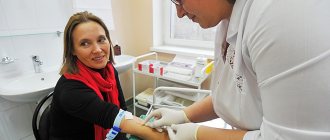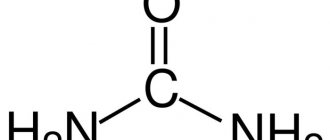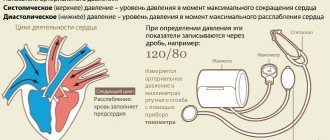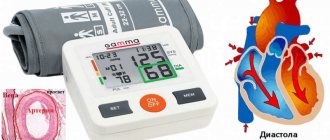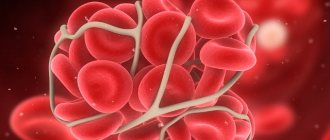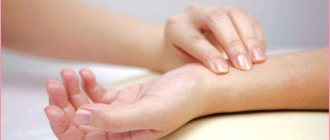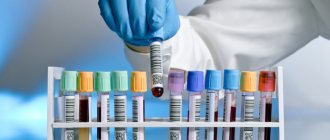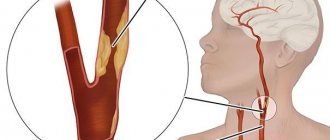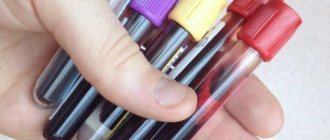5 / 5 ( 2 voices)
Pulse or heart rate (HR) demonstrates how fast an organ works, the main function of which is pumping blood to supply blood to the entire body. How well the cardiovascular system works and whether there are problems in the work of all its components is determined by the pulse in children. By age, the table will show how often the heart should contract depending on the age of the child.
The child’s pulse needs to be monitored in case of chronic and acute diseases
A change in contraction frequency is a normal state of the body. The heart adapts to the stress of the body. Speeds up or slows down to get the job done efficiently.
There are no absolutely exact figures for how much a child’s pulse per minute should be; there are approximate values within which the heart rate fits without pathological changes in the functioning of the system.
Heart rate norms
In the fetus
You can notice fluctuations in the baby’s heart at the beginning of the first trimester; the rhythm is rapid and changes with the development of the fetus. Pulse at 6–8 weeks is 110–130 beats, from 8 to 11 it reaches 190, from 11 weeks – 140–160, varies several times a day.
In newborns
- The heart rate of a baby (the first 4 weeks after birth) with anxiety increases to 160–200 beats.
- 120–140 beats is normal.
- Children born prematurely have a higher heart rate than a child born at full term.
In infants
A baby is considered a child from 30 days to 1 year. By the age of one year, the baby’s normal heart rate is 132 beats. Normally, the heart rate in children increases to 162.
In young years
In a child under 7 years of age, the nervous system is at a stage of intensive development, which is the reason for the increase in heart rate in children. For a 2-year-old child, the normal heart rate is 124 beats; physical activity or stress leads to a frequency of 94 to 154 beats.
In preschoolers
The age of preschoolers is conventionally divided into three periods:
- junior preschool age - from 3 to 4 years;
- average preschool age - from 4 to 5 years;
- senior preschool age - from 6 to 7 years.
The normal pulse rate for 6-year-old children, as can be seen from the table, is 106 beats.
The heart rate of school-age children is 80–120 beats.
In children 9–10 years old, the normal heart rate is considered to be 108 beats per minute.
In teenagers
Pulse rates in adolescents gradually drop to 65–100 beats, and upon reaching puberty they reach 60–90 beats. The teenager's heart rate is normal - 75
Normal heart rate in children during sleep.
Sleep is a state of rest for a person. But from the point of view of sleep theory, slow-wave sleep and rapid sleep are distinguished. NREM sleep has three stages of depth, designated by the Latin letter N, respectively N1, N2, N3. These stages differ in the behavior of the brain during sleep, recorded on the electroencephalogram. Thus, the first stage is characterized by theta waves, the second - the so-called “sleep spindle”, and the third - delta waves. But the common thing is that during this sleep a person does not dream, the muscles are in a state of tone, breathing and heart rate slow down. After N3, the rapid eye movement stage begins. At this stage, all muscles are in atony, that is, completely relaxed, except for the muscles of the eyeballs, a person dreams at this time, the pulse and breathing rate may increase, and men have an erection during this stage of sleep. In general, the way we see sleep is a heterogeneous state. And your heart rate can fluctuate significantly during sleep. However, in most cases, when we observe a sleeping child, these are the first stages of sleep, which corresponds to a state of complete rest, so the pulse during sleep, as a rule, should correspond to the above standards for a state of rest. But if you measure your child’s pulse while he sleeps and it turns out to be elevated, don’t sound the alarm, you may just be in the “rapid eye movement” phase. Wait until the child wakes up and measure the pulse again while at rest, sitting or lying down.
Pivot table
| Age | Minimum (bpm) | Average value (bpm) | Maximum (bpm) | |
| In newborns | Up to a month | 110 | 140 | 170 |
| In infants | From 1 month to a year | 102 | 132 | 162 |
| In young years | 1–2 years | 94 | 124 | 154 |
| In preschoolers (younger preschool age) | 3–4 | 90 | 110 | 130 |
| For preschoolers (middle and senior preschool age) | 5–6 | 86 | 106 | 126 |
| For schoolchildren | 7–8 | 78 | 98 | 118 |
| 9–10 | 68 | 88 | 108 | |
| 11–12 | 65 | 82 | 100 | |
| In teenagers | 13–15 | 63 | 79 | 95 |
| 16–18 | 60 | 75 | 90 | |
Skipping or extra beats in the pulse indicate heart disease.
How to calculate heart rate?
Children's pulse measurements are taken after eating and in a ventilated room. Before starting to count the heartbeat, wait until the child calms down and put him in bed with his arm extended, palm up. In children, the pulse is measured at the radial artery.
Using the tips of 2, 3, 4 fingers, feel the artery and gently press it. Count your heartbeats in 60 seconds. To clearly understand the child’s heart rate, repeated measurements are taken. During deep sleep, children's heart rate is minimal and reaches its maximum value at approximately 10–12 o'clock.
Do not put too much pressure on the carotid artery, as this will lead to dizziness.
What influences the indicators?
Factors influencing heart rate indicators:
Age
The heart rate decreases as the child gets older. When a baby is born, the heart beats approximately 120 times per minute. Children have a heart rate of 100 beats. In people under 65 years of age, the heart rate should be 70–80. People over 65 years old have a heart rate of 60.
Physical activity
During physical exercise, the human body's organs work intensively, which is facilitated by an increase in oxygen consumption. The supply of oxygen to muscle cells forces blood flow and heart rate to increase.
Health status
Children's heartbeat is negatively affected by: negative emotions, digestive problems and feelings of fear. Deviation of a person's weight from the norm leads to a change in heart rate.
Medicines
Drugs that patients use to prevent or treat blood pressure narrow or dilate the blood vessels of the heart, thereby increasing or decreasing the heart rate.
Let's sum it up
The life and health of children are in the hands of their parents. The responsibilities of adults include monitoring the child’s well-being and promptly seeking medical help if necessary. In addition, parents are obliged to protect their child from the influence of negative physical and psychological factors that pose a threat to the life and health of the little person.
In the article, we found out that the pulse is a very important indicator of child health, by which one can suspect certain diseases. Constant monitoring of the frequency of contractions of the heart muscle is an important condition for the timely detection and treatment of various pathologies in children. That is why regular monitoring of children’s pulse is the key to their health.
Why does your heart rate change with age?
The human heart, like any muscle, grows (aging) as we grow older and loses the elasticity of the blood vessels of the circulatory system. The total length of human blood capillaries reaches 100,000 km; waste and toxins constantly accumulate in them.
Reasons why heartbeat changes over the years:
- ineffectiveness of the heart muscle;
- decreased elasticity of blood vessels;
- increased sensitivity to adrenaline (the fear hormone).
These factors lead to a decrease in the volume of blood ejected by the heart and a decrease in heart rate.
Symptoms and causes of low readings
Low heart rate (bradycardia) in children can be acquired or congenital. The disease is diagnosed:
- in newborns with a pulse less than 100 beats per minute;
- in children 1–6 years old: 79–80;
- in school age: less than 60 beats.
Symptoms:
- weakness;
- profuse sweating;
- instability
- loss of consciousness;
- loss of appetite;
- the appearance of shortness of breath.
Accurate identification of the cause of the disease guarantees effective treatment.
The causes of low blood pressure may be:
- systematic fasting;
- hypothermia;
- infectious diseases;
- poisoning of various types.
Diseases directly related to the work of the heart (atherosclerosis, hypotension, myocardial infarction, endocarditis) also help reduce the patient’s blood pressure.
If your heart rate is below 50 beats/min, contact your doctor immediately.
Reasons for deviations in heart rate values
If a child’s heart rate differs significantly from the age-appropriate level, this may be a symptom of a pathological condition.
There are two types of deviations:
- tachycardia - acceleration of the rhythm;
- bradycardia - slow pulse.
Tachycardia
Rapid heartbeat can be due to one or a combination of reasons, depending on the age of the child and his condition:
- hormonal changes in adolescents (especially during puberty, 12-16 years old), or disruption of the endocrine system (at any age);
- anemia (low hemoglobin);
- neuropsychic disorders, stress;
- severe fatigue, overwork;
- high body temperature;
- pathologies of the cardiovascular and respiratory systems.
The acceleration of the rhythm may be transient and does not require treatment. Thus, in girls aged 12-14 years, during puberty, the pulse can deviate significantly from the norm after heavy and prolonged menstruation.
The same picture is observed in boys during the period of active hormonal changes at the age of 12-16 years. With the end of puberty, heart rate, as a rule, normalizes on its own.
Bradycardia
A slow heart rate is not a deviation in most cases. If bradycardia is present against the background of good health, then this indicates that the child has a healthy, actively functioning heart.
A decrease in heart rate is typical for athletes with a trained respiratory and cardiovascular system. Regardless of the number of years one has turned, a slow heart rate can be observed during periods of intense growth.
If bradycardia occurs suddenly and is accompanied by lethargy, severe fatigue, dizziness, and pallor, it is necessary to consult a doctor as soon as possible to determine the cause of this condition.
We recommend reading: Blood pressure and pulse in a child from 0 to 9 years old
Symptoms and causes of high readings
A high heart rate (tachycardia) is considered normal in children under 7 years of age.
An increase in the child's body temperature by 1 degree increases the pulse by 7-12 beats.
Symptoms:
- painful tremors in the chest area;
- numbness of fingertips;
- feeling of fainting;
- blurred vision;
- cold extremities;
- general weakness.
Causes:
- thyroid dysfunction;
- pathology of the upper chamber of the heart;
- lung disease.
Coffee, tobacco, tea, lack of vitamins, nervousness, fear, rich foods also stimulate an increase in heart rate
And also read: what to do with a rapid pulse at low, normal and high blood pressure?
What to do to normalize heart rate?
If children exhibit symptoms of tachycardia, immediately remove tight clothing, lay the baby down, and provide access to fresh air. Soak a towel in cold water and place it on the forehead to distract the child’s attention. If the condition does not improve, you can resort to medications (validol, valerian), while simultaneously massaging the front of the neck.
Decoctions and tinctures of medicinal herbs: mint, valerian, motherwort, hawthorn are excellent stimulants for stabilizing heart function. It is useful to systematically drink tea that contains: lemon balm, valerian or hop cones.
For tachycardia, it is advisable to limit the use of:
- coffee;
- black tea;
- sweets;
- salt;
- eggs;
- butter.
Quit tobacco and alcohol!
Walking and getting enough sleep help children recover.
Bradycardia in children does not cause attacks; its detection requires a mandatory visit to the doctor.
Recommendations for action
If the newborn does not have any serious illness or infection, it is possible to normalize breathing at home. To do this, follow some rules:
- Place the newborn on his back while sleeping; when an attack occurs, turn him on his side;
- add more vitamins and minerals from vegetables and fruits to your baby’s diet;
- Start doing breathing exercises with your baby. 3 times a day for 15 minutes will be enough. Take a slow deep breath through your nose, exhale through your mouth;
- if you are sure that the attack was caused by stress, use a sedative or herbal tincture;
- if there is no breathing, try to wake the child, let him smell ammonia, wash him with cool water.
Important! Severe and prolonged disruption of the respiratory process or its disappearance requires urgent action: call an ambulance.
In such a situation, the baby should not be given any medications so that the doctor can clearly see all the symptoms. But remember, the respiratory rate and heart rate decrease over time, so do not forget to check them with the table.
Respiratory rate and heart rate are important indicators of the baby’s condition, which are easy to monitor. Violations of one or both of the indicators are interrelated. They mean the presence of a disease and requires medical intervention. Keep an eye on your child and do not create future age-related problems for him.
